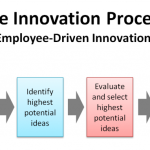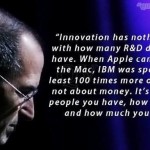One of the many joyful experiences of my Henley MBA was the short optional course on innovation led by a chap whose name eludes me but who was a true British eccentric along the lines of John McCririck without the racing pedigree. It pleased me for several reasons, one being the close relationship with Knowledge Management, the topic on which I was writing my dissertation, and another being that many of my clients made such a laboured job of innovating new ideas.
But let’s start with a few definitions. An Innovator could be but is not necessarily the inventor of an idea or product or service or change, but is always the person who exploits that idea or product or service or change such that it realises the benefits for which it was dreamed up. An innovator could therefore be an entrepreneur, the one who spots a gap in the market and who forges an enterprise based on launching it when its moment arrives upon an unsuspecting public, who then buy in droves and make money for the business – or who are provided with a slicker service. You could patent your idea and hope that someone is prepared to pay to licence your idea – but equally, an innovator might simply do something for the love of it, without expectation of financial reward, because it enhances life and pleasure. One such was the use of an envelope to carry the now defunct floppy discs. It didn’t add greatly but the chap concerned had patented the idea – along with 10 more simple ideas.
The joy is that anyone can do the innovating without expertise, capital or technology. All you need is to be observant and to spot opportunities to question the inherent assumptions about why we do things in a particular way.
The point of innovation is that the ideas are often a step change, something so simple that people later wondered why they hadn’t been thought of before, and often in related clusters. Can you imagine what life was like before the commercialisation of electricity? Or the light bulb that followed on? Or the electrical appliances that add to our everyday convenience?
Here is Business Week‘s take on what makes for a great innovations:
Here’s how we chose the most invaluable innovations ever:
1. It saved lives, extended average lifespan, or materially improved the quality of life.
Examples: anesthetics, surgery, vaccines, antibiotics, and genetic screening.
2. It led directly and indirectly to downstream derivative innovations that fundamentally altered how we live and what we are able to do as a species.
Mathematics, money, property ownership, and containerized shipping make the list. The Internet makes it, but Google, Microsoft Windows, and iPods do not.
3. It helped to increase the amplifier effect of modern economies–increasing the standard of living for the population as a whole.
Printing, free markets, capital markets, and limited liability each do this.
4. It freed up people’s time to do something besides just scramble endlessly for the food and shelter and clothing they need to survive.
This is where the logic of Jared Diamond’s brilliant treatise Guns, Germs and Steel was helpful. Examples: weapons, domesticated animals, agriculture, and participative democracy.
We believe it is analytically impossible to definitively reduce these (and any similar) grandiose indices to deterministic ratings, say on a 1- to 100-point scale. Naturally, we would love to have this belief challenged.—Larry Keeley, president, Doblin
The thing about good ideas is that they seldom arrive fully-formed and generally need an iterative process involving sone degree of creative tension between different people with different visions before they mature into a product or outcome that delivers real and tangible benefits to its target audience. In KM theory it is described as a spiral in the Ba methodology, whereby time and space, maybe virtual, are required to enable the idea or vision to take shape. A process to facilitate that cycle may be found in the course of repeated prototyping, which works best because most people find it easier to focus something tangible that you can see, touch, hear or I’m some other way experience through the senses.
Strangely enough this can equally apply to concepts that can’t be sensed conventionally. For example, one organisation I worked with had cause to implement a culture change programme, which as anyone who’s been there will tell you is a fiendishly difficult thing to do, is subject to repeated failures and unforeseen consequences, and is rarely understood. One of the tools used for this process was what amounted to a card game aimed at promoting the correct behaviours given a range of circumstances.
The bottom line is that you have to be able to communicate the idea in terms almost anyone can understand without fear of misinterpretation, and that the benefits should be so plainly obvious they don’t need to be articulated.
Which brings me to a second property of most good innovations: they should generally enable the simplification of any task for which they are intended, such that several process steps are removed and/or time saved and/or progress in the task is much easier to achieve. The simpler the innovation, the more likely it is to succeed. On this topic, one book I’m find of is Simplicity by Dr Edward de Bono, which demonstrates precisely how difficult it can be to achieve simplicity, since it usually involves hiding or removing many layers of complexity.
This is particularly difficult in large and complex organisations. A number of years ago I did some work for a giant of the telecommunications industry on a programme designed to streamline how fast they responded to the needs and wants of customers in order to reach market before their smaller, faster-moving competitors. Upon closer examination it became clear that the sales force was listening to customers and reporting what they asked for, but the problems came when the requests went through multiple layers of bureaucracy before arriving with product designers. The finished product, based on multiple layers of interpretation and Chinese whispers, was typically months late, did not necessarily do what the customer wanted in the way it was wanted, was over-engineered and far too costly, and often included many features the customer would not use. This became known as “dead cat syndrome” since the sales force assured their management that the cat (the customer’s vision of the product) was alive at the start, but by the time it had been thrown over several walls within the organisation the cat was dead!
More than that, the point was that if the company had pretensions to being an innovator it had to pre-empt the market and develop what the customer wanted before they realised they wanted it, knowing that sometimes you will screw up and deliver a white elephant, but more often you will steal a march and capture a new audience for your products. That is the difference between, say, Apple as a technological innovator and other companies who follow into markets later with “me too” products, probably a bit cheaper and not quite as sexy, but equally saving on development costs. For example, Apple did the legwork to establish a market for tablets with the iPad, and the competitors followed soon after.
So, to get back to my story, this was very much a battle for the soul of the organisation in question, but after much hand-wringing it did finally decide to be an innovator. To achieve this feat found ways for sales people to talk direct with product designers, and to have the ba – the time and space – to play with ideas in order to anticipate where the market might be heading in 2-3 generations’ time. It might have succeeded to some degree but it is still too slow-moving to create vast new markets in the way a true innovator might. But to be fair, it did largely eliminate dead cats from its repertoire.
So to a third rule of innovation, which is this: innovation is cumulative, so ideas can be recycled, used in different ways and in different combinations. Sometimes an idea might be discarded but then end up in a completely different context from where it began life, but its time finally came. It’s all part of your inventory and can always add value at some time in some way. Famously, 3M stumbled upon the Post-it Note innovation while trying to create something quite different:
In 1968, a scientist at 3M in the United States, Dr. Spencer Silver, was attempting to develop a super-strong adhesive. Instead he accidentally created a “low-tack”, reusable,pressure-sensitive adhesive. For five years, Silver promoted his “solution without a problem” within 3M both informally and through seminars but failed to gain acceptance. In 1974 a colleague who had attended one of his seminars, Art Fry, came up with the idea of using the adhesive to anchor his bookmark in his hymnbook. Fry then utilized 3M’s officially sanctioned “permitted bootlegging” policy to develop the idea. The original notes’ yellow color was chosen by accident, as the lab next-door to the Post-it team had only yellow scrap paper to use.
By such accidents great ideas are borne, but it still takes somebody to realise the potential and market the solution.
Which brings me neatly to the fourth rule, a natural corollary of everything discussed above: within any organisation the power to innovate, the intellectual capital, resides within the employee base. If you want to harness and exploit that power you have to give people licence to be creative. But the other thing is that you can never steamroller people into creativity – it comes at its own pace. Some incentives might be welcomed but the killer idea might come at any time from any source – if at all – and often by a complete fluke. You can’t manage to guarantee innovation but you can nurture it by allowing communities of interest to flourish as a subculture within the organisation, and provide them with the tools they need to exchange ideas and forge new ones.
This is an alien concept to traditional command-and-control styles of management since it demands a hands-off approach with strong measures of democratic independence and freedom within the organisation: “the hardest part is letting go.” The effect of laissez-faire leadership tends to be a flow of mew product and service ideas, for which the knack is to identify and exploit those worth using very rapidly. This also explains why so many organisations, especially in the public sector, are so bad at implementing new ideas for change and improvement.
So if I leave you with any message it’s that you should never downplay your creativity. You may stumble into innovating something out of the blue, and your imagination may be sparked by something said to you on the bus or anywhere. Just don’t think its a great idea but then do nothing – visualise what it could be. Run with the idea and see where it takes you. Who knows, it might be your claim to fame, like Percy Shaw, the chap who invented cat’s eyes – though the stories varied about what inspired him. Simple idea but one that saved lives and set Shaw up for life. Why not you too?









